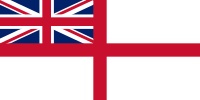Royal Yacht Squadron: Difference between revisions
Springnuts (talk | contribs) m Reverted edits by 81.105.181.49 (talk) to last version by 86.24.195.62 |
Donan.raven (talk | contribs) mNo edit summary |
||
| Line 62: | Line 62: | ||
==External links== |
==External links== |
||
* [http://www.rys.org.uk Official website] |
* [http://www.rys.org.uk Official website] |
||
*{{cite book|url=http://www.us.archive.org/GnuBook/?id=royalyachtsquadr00guesuoft|author=Montague John Guest|date=1902|title=The Royal Yacht Squadron|publisher=John Murray Press}} - list of every member, yacht and event until 1902. |
|||
[[Category:Yacht clubs in England]] |
[[Category:Yacht clubs in England]] |
||
[[Category:Organisations based on the Isle of Wight]] |
[[Category:Organisations based on the Isle of Wight]] |
||
Revision as of 08:40, 26 May 2009
 Burgee | |
| Founded | 1815 |
|---|---|
| Clubhouse | Cowes Castle, Isle of Wight |
| Country | |
| Admiral | HRH Prince Phillip |
| Commodore | Robert Peter Richard Iliffe, 3rd Baron Iliffe |
| Head Steward | James Kitteridge |
| Website | http://www.rys.org.uk |
The Royal Yacht Squadron is the most prestigious yacht club in the United Kingdom.[1]. Its clubhouse is located in Cowes Castle on the Isle of Wight in the United Kingdom. Member yachts are given the Suffix RYS to their names, and permitted to fly the White Ensign of the Royal Navy[2] rather than the merchant Red Ensign flown by the majority of other UK registered vessels. The club's patron is Queen Elizabeth II and the club’s Admiral is Prince Philip who is also a former club Commodore.
History
Founded on the 1st of June 1815 in the Thatched House Tavern in St James’s, London as The Yacht Club by 42 gentlemen interested in sea yachting[3]. The original members decided to meet in London and in Cowes twice a year, to discuss yachting over dinner. Membership was restricted to those who owned a vessel not under 10 tons. Today this is interpreted as a gentleman “actively interested in yachting”[2].
The Earl of Yarborough, later first Commodore of the Yacht Club, welcomed the Prince Regent as a member in 1817. In 1820, when the Prince Regent became George IV, it was renamed the Royal Yacht Club.
The Club starting organising racing as a principal feature of the annual regatta, which is now known as Cowes Week. In 1833 William IV renamed the club, The Royal Yacht Squadron. Its association with the Royal Navy began early and Nelson's Captain at Trafalgar, Admiral Sir Thomas Hardy, headed the list of Naval members. The spirit of invention led to yachts “of such celerity in sailing and beauty of construction” that they were of utility to the Royal Navy.
In 1829 the Admiralty issued a warrant to wear what is now the navy’s White Ensign. The burgee (a triangular shaped flag identifying yacht club membership) is differenced with a St George's Cross and crown on a white background.
Racing

In 1851, the club's Commodore, visiting the Great Exhibition, issued a challenge for the Squadron’s £100 Cup for a race around the Island. The New York based ‘’America’’, representing the New York Yacht Club triumphed in this race giving its name to one of the oldest and best known trophies The America's Cup. The victory was witnessed by Queen Victoria and the Prince of Wales, later Commodore of the club and Edward VII.
During the American Civil War Deerhound RYS witnessed the fight between USS Kearsage and the Confederate cruiser Alabama. Gazelle RYS rescued the Empress Eugenie at the end of the Franco-Prussian War and the Squadron yachts supplied British Soldiers in the Crimean War.
The German Kaiser brought the 1887 ex-America’s Cup challenger Thistle, to Cowes in 1892 which encouraged the Prince of Wales to build Britannia, one of the most successful racing yachts of all time.
The Pavilion
The Pavilion, designed by Sir Thomas Croft, was opened in 2000. This elegant creation provides on shore facilities for yachtsmen and their families while allowing the Castle to retain its ‘Country house’ ambiance. The Pavilion also enabled the Squadron to cross burgees with the New York Yacht Club in celebration of the 150th Anniversary of the Schooner America’s famous victory of 1851.

References
External links
- Official website
- Montague John Guest (1902). The Royal Yacht Squadron. John Murray Press. - list of every member, yacht and event until 1902.

